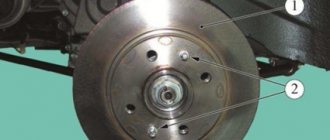Car dimensions
Car interior
Engines Lada Vesta and Kia Rio
Gearbox Lada Vesta and Kia Rio
The domestic novelty has become a serious competitor for foreign car brands. Kia Rio was no exception. This car, together with its compatriot Hyundai Solaris, occupies a leading position in the sales ranking in the B segment on the Russian market. Korean models are rapidly gaining a large number of fans, but the new AvtoVAZ product is not going to give up the laurels of championship. Today we will try to find out which is better Lada Vesta or Kia Rio.
The appearance of the first worthy Russian car cast doubt in the minds of many potential buyers, who now find it difficult to determine what to buy. On the one hand, there is a time-tested Korean authority, and on the other, a bright and dynamic “upstart”. Reviews 2022 and videos shot warmly characterize today's opponents.
“Korean” becomes stronger over time and attracts the attention of the majority. Now this brand commands sincere respect, which it has honestly and conscientiously earned. The Lada Vesta shatters stereotypes, as it was produced at a plant whose work had previously only been depressing and confusing. She is slowly approaching respectability and is ready to take any blow from criticism. It will be difficult to choose, as opinions vary.
Body dimensions
Dimensions of cars First, it is worth comparing the Lada Vesta and Kia Rio in this aspect. The former currently only has a sedan, while the latter also includes a hatchback.
On a note!
The designers and heads of AvtoVAZ diligently promise the appearance of a station wagon and a sports coupe. These achievements will allow the new product to climb to a higher level in competition with foreigners.
- the length of the “Korean” is 4 m 38 cm, the opponent answers 4 m 41 cm;
- the width of the Kia Rio body is determined by the figures 1700 mm, for the Lada Vesta - 1764 mm;
- the domestic sedan also has superiority in height - 1 m 50 cm vs 1 m 47 cm;
- the ground clearance of the Lada Vesta is one of the largest in the class (178 mm), the Kia Rio boasts only 160 cm of ground clearance;
- in luggage compartment volume, the domestic product has an advantage of 10 liters - 480 versus 470;
- Lada Vesta is much heavier - 1230 kg and 1055 kg for Kia Rio. The full load of the first is 1670 kg, the “Korean” holds 1570 kg;
- wheelbase: 2 m 64 cm versus 2 m 57 cm, the product from AvtoVAZ also wins here.
Interior features
Steve Martin, chief designer of AVTOVAZ, has developed a stylish design for the Vesta Cross, which many like even more than the design of its Korean competitor. But in comparison with the comfort of the interior, the Lada Vesta Cross is inferior to the Kia Rio X Line: the lumbar support of the back of the front seat seems to be a good find, but the lower cushion is made too short.
Compared to Rio, the seat is more rigid and uncomfortable. And Lada passengers in the second row will be much more comfortable thanks to the large gap between the back of the seat and the knees. A characteristic feature of both models - a sloping ceiling - looks stylish, but a tall passenger will prop it up with his head.
The quality of the interior and its equipment is inferior to Vesta: a rather harsh steering wheel, stiff window lifter buttons. Data from the speedometer scale is difficult to read. The steering wheel has pleased car enthusiasts - it is conveniently adjustable in terms of inclination and reach. Both models have curtain airbags on top trim levels.
Vesta offers seat upholstery in black + gray and black + orange. Kia has a color combination: black + red. The Korean's interior materials are better in appearance than those of the Russian station wagon.
Comparison of Lada Vesta and Kia Rio in terms of appearance
Both models make a pleasant impression, so it is quite difficult to single out a leader in this aspect. The competitors' exteriors are fast and modern, but executed with completely different strokes of the designer's brush.
Car interior
Interesting!
It is absolutely clear that the KIA Rio and Hyundai Solaris are actually twins in technical terms and have the same “parent”. The latter is aimed more at serious people over 35 years old, the first was created with an eye on the young and impulsive generation.
- The entire image of the car is permeated with “flowing” features. The Kia Rio radiator grille is shaped like the nose of a predatory animal, and the narrow optics create the impression of a sly look. The air intake is decorated with a chrome baffle, and buyers also appreciate the fog lights that complement the look.
- Looking at the profile, you notice a slight forward roll. The side panels are framed with stylish stampings. The chrome grabs the window opening without disturbing the mirror and adds some sparkle.
- The rear end completes the look with large and harmonious taillights, a sloping roof and a neatly integrated trunk.
Lada Vesta is not going to give in, as it has a completely memorable image:
- The aggressive and dynamic style consists of classic headlights, a powerful air intake and an equally colorful radiator grille with rare veins of chrome. This exterior attracts people of all ages.
- The wheel rims on the profile side, as well as the “X-style” stampings on the door, define the car as a standard of pressure and courage.
- The back part with its especially large fragments makes you more and more zealously riveted on this dynamic beauty.
Cost of ownership
Maintenance of models deserves special attention. Let's calculate how much routine maintenance at official dealers in Moscow will cost up to a mileage of 60 thousand kilometers (inclusive) for cars with the least powerful engine and manual transmission. Maintenance of Lada Vesta 1.6 (106 hp) 5MT costs: TO-1 (15 thousand km) - 6600 rubles, TO-2 (30 thousand km) - 8800 rubles, TO-3 (45 thousand km) - 6600 rubles, TO-4 (60 thousand km) - 8800 rubles, and Kia Rio 1.4 (100 hp) 6MT: TO-1 (15 thousand km) - 7725 rubles. , TO-2 (30 thousand km) - 9945 rubles, TO-3 (45 thousand km) - 8384 rubles, TO-4 (60 thousand km) - 13316 rubles. The total cost of all Vesta vs Rio maintenance was 30,800 rubles. vs 39,370 rub., i.e. 8,570 rubles (28%) more expensive to service a Korean sedan. As a result, it turns out that for every kilometer driven, Lada pays 51 kopecks for maintenance, and Kia pays 66 kopecks.
The cost of CASCO (theft and damage insurance) is also a very significant expense item when purchasing a new car for those owners who decide to purchase an insurance policy. How much will such risk protection cost? To answer this question, let's compare CASCO prices for cars worth 800,000 rubles for a 30-year-old man with 10 years of experience without children. For example, at Renaissance the CASCO policy will cost 23,796 rubles. for Vesta and 43,460 rub. — for Rio, in the company Rosgosstrakh — 24,826 rubles. and 26,010 rubles, and in the MAX company - 89,100 rubles. and 112,600 rub. respectively. These prices are obtained from online calculators and should not be considered final. However, in their relative terms, it is obvious that insuring a Russian car will be cheaper.
Lada Vesta or Kia Rio: power under the hood
Engines Lada Vesta and Kia Rio Both cars have two types of internal combustion engines. In the near future, as the designers of the Russian plant promise, new modifications of the Lada Vesta model range will be equipped with a high-quality and reliable engine from developers from the Renault-Nissan alliance.
- The first power unit is an internal combustion engine with a power of 107 horsepower and a volume of 1.4 liters. Maximum torque – 135 N/m. The car accelerates to hundreds in 12.5 seconds. The highest speed of a car with such an engine is 170 km/h. Fuel consumption is low: 7.5 liters. In the city and 5.5 on the highway.
- The answer to the Lada Vesta is an internal combustion engine with a power and volume of 106/1.6. This unit accelerates the iron horse to hundreds in 11.8 seconds, and the maximum speed is 178 km/h. The fuel consumption of the domestic product is quite significant: 9 liters in the city, 6.5 on the highway.
- More expensive versions of the Kia Rio are equipped with a 122-horsepower unit with a volume of 1.6 liters. Peak torque is 155 N/m, which allows for a top speed of 180 km/h. Acceleration to hundreds is determined by 10.3 s.
- The powerful 1.8/122 engine of the Lada Vesta has a torque of 170 N/m according to the instrument readings. The engine life will be 200,000 km, and the car can accelerate to 190 km/h. Fuel consumption depends on the type of terrain and gearbox, but remains high.
Let's start the comparison with: equipment and cost
The domestic Lada Vesta has 6 trim levels, the Korean Kia Rio has 7. Some are very different, others have similar details. Thus, the Lada Vesta Classic has two airbags, a built-in ISOFIX fastening system, stamped 15-inch wheels, mirrors with turn signals, an on-board computer, and other functions. The Lada Vesta Classic/Start and Lada Vesta Comfort configurations repeat the classic version, supplemented with some functions: air conditioning, several mirrors, adjustable driver's seat. Lada Vesta Luxe is equipped with 16-inch wheels, door lights, light and rain sensors. A wide selection allows the buyer to practically assemble a suitable car.
The Kia Rio Comfort package is equipped with front airbags, ABS, ESS systems, steel wheels, and other functions. Its closest sisters, the Kia Rio Comfort Air Conditioner and the Kia Rio Comfort Audio, are almost exactly the same as the standard version. The Kia Rio Luxe package additionally includes door cards, automatic lighting shutdown, and full power accessories. Kia Rio Prestige offers side airbags, a heated windshield, and a windshield washer system. Kia Rio Premium, in addition to prestige, has a stability control system, 16-inch wheels, and keyless entry.
What about transmissions?
Lada Vesta uses two five-speed manual transmissions: domestic (VAZ-2180) and French (JH3 510). The basis of the Russian manual transmission is taken from Priora and significantly redesigned with foreign components. Instead of an automatic transmission, Vesta uses a 5-band AMT (robot), which has lower operating and repair costs.
Gearbox Lada Vesta and Kia Rio Kia Rio is equipped with two manual and two automatic gearboxes. The first “mechanics” has 5 stages, the second – six. The Korean transmission works clearly and smoothly. “Korean” “automatic machines” have 4 ranges and 6, respectively. In this aspect, Kia Rio has practically no competitors.
Price of body parts
Before buying a car, the decisive factor influencing the final choice is the price of body parts. Here the Lada Vesta becomes the undisputed leader. The cost of individual Rio parts exceeds the price of the same Vesta parts by 2-3 times. The difference is especially noticeable when replacing the trunk lid, bumpers and side mirrors. Thus, the trunk lid of a Russian car on average costs about 7,000 rubles on the market, while the purchase of a part for a Korean will require all of 14,000 rubles. The difference in the price of front bumpers is even more noticeable: from 3,000 rubles for a Vesta to about 10,000 rubles for a Kia Rio.
Chassis
The suspension designs do not shine with originality and originality; everything here is optimal: there are MacPherson struts in the front, and the body rests on a torsion beam at the rear. The handling of the models is somewhat similar, however, the higher ground clearance of the domestic sedan allows the driver to cope somewhat better with bumpy terrain.
On a note!
The Kia Rio is pleasant to drive, but at high speed the rear end begins to wobble. Manipulating steering is tiring, especially on the highway.
conclusions
From the point of view of the development of the Russian automobile industry, Cross can be considered a definite breakthrough. The station wagon model is not very popular in Russia yet, but has great potential.
The Kia Rio X Line is superior to the Russian Cross due to its high profile tires and automatic transmission. But the AVTOVAZ model has greater cross-country ability due to its ground clearance, and will also attract consumers with a spacious interior and ergonomic trunk.
Comparing prices and configurations, it can be argued that the Cross is more economical than the Korean. But, looking into the future, we also need to evaluate maintenance and the warranty period, which the Korean has longer.
Comparison of interior and prices
There is an assumption that Russian designers were greatly impressed by the Kia Rio interior, which is why the interiors are so similar. They are practically indistinguishable from each other: the center console, the dashboard, encased in plastic, and the steering wheel itself with a special handle. The designers did not forget to install heated seats and glass. Ergonomics and speed of delivery will not make the buyer nervous, and overall visibility increases the chance to better see the purchase of one of the competitors.
Opponents offer a wide range of trim levels to choose from: Lada six, Rio seven. The price of the first is much less than the cost of the second: 515,000 versus 600 thousand rubles. The difference is quite significant for segment B. The maximum price for a “Korean” is 870,000 rubles, the most expensive Vesta can be bought for 660,000 rubles. What to choose: Vesta or Rio - this question can be complicated and will only be resolved after the buyer decides exactly what he wants from the car. Numerous videos and photos can help with this.
What is the final result?
The domestic car model is capable of not only competing with its Korean counterpart on an equal footing, but in some cases even significantly surpassing it. It is worth considering that AvtoVAZ always listens to its consumers. For this reason, it is quite possible that in the near future those nuances that cause some dissatisfaction will be finalized. Before the sedan appeared on the country's automobile markets, it was redesigned more than twenty times.
Moreover, do not forget about the cost of cars. Vesta with a 122 horsepower unit will cost only 633 thousand rubles. For a Korean car assembled in St. Petersburg, you will need to fork out 767 thousand rubles. Whether it is worth giving that kind of money is definitely up to the buyers to decide.
Car design and exterior
VAZ managed to make a stylish body, which in its appearance is in no way inferior to its closest competitors.
Both sedans have sporty lines. This can be seen in the streamlined shape, the “aggressive” bumper and elongated rectangular headlights. The Kia Rio's radiator grille is narrow and less pronounced. In a Russian car, the emphasis is on it.
Exterior view of the Lada Vesta. Photo source: https://www.drive2.ru/o/b/486028670771659178/
From the rear, the latest version of the Korean car looks in line with modern trends. Its headlights are connected to each other by a thin red stripe, and the muffler is disguised. Some versions of the Lada have a double exhaust pipe that immediately catches your eye. The rear lights are more clumsy and angular.
Among station wagons, it’s also not possible to clearly choose who turned out to be more stylish: Ka Rio X-Line or Lada Vesta SW Cross. Like sedans, these body styles are similar in many ways. The Rio has higher roof rails and chrome door handles, while the Lada has them in body color.
Specifications
Engines
It is worth recognizing that KIA engines are noticeably better, and there are more of them. Rio offers the buyer a pair of 16-valve power units, and the 1.4-liter aspirated engine opens the line. Despite its small volume, its output is decent - at 6,300 rpm the engine develops 107 hp. s., with 135 Nm of torque at 5,000 rpm, providing the KIA Rio owner with acceleration in 11.5 seconds, and in total the sedan can reach 190 km/h (170 km/h with AT).
1.4-liter naturally aspirated KIA Rio.
His opponent is the 106-horsepower LADA Vesta engine. The difference in power is only 1 liter. s., almost the same acceleration speed to hundreds (11.8 sec.), as well as similar peak power and torque levels (5,800 and 4,200 rpm, respectively) provide both models with approximately the same character, quite sufficient for normal movement in the city and on track. But the declared consumption of Rio is noticeably less - in the city and on the highway it is 7.8 and 5.0 liters, versus 9.3 and 6.9 liters for the Russian model.
The 106-horsepower engine of the LADA Vesta is the main competitor of the Korean.
But the 1.6-liter engine of Rio and Vesta still have nothing to oppose. Korean engineers managed to achieve impressive success by removing 123 liters from the standard volume. With. power, while completely retaining the simple atmospheric design. This output is achieved at the same 6,300 rpm, but the thrust not only increased to 155 Nm, but its peak dropped to 4,200 rpm. This made it possible to keep the maximum speed at the same level and make the car noticeably more dynamic - changing hundreds takes only 10.3 seconds.











